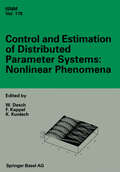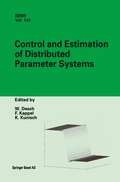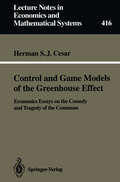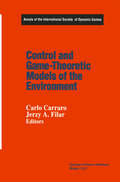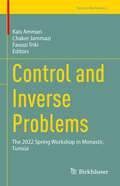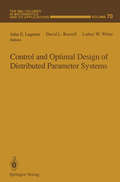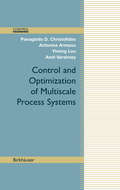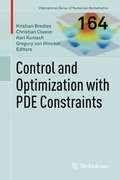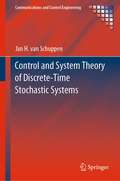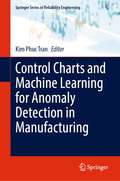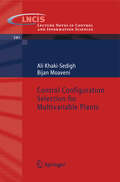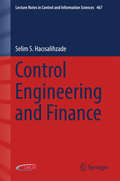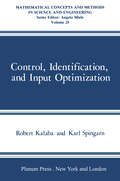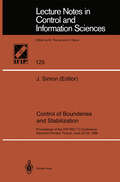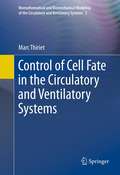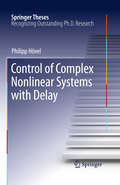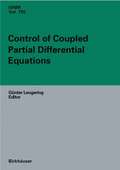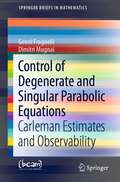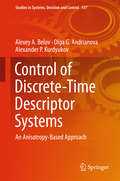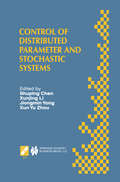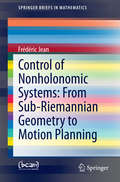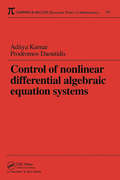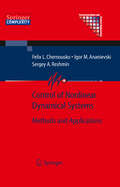- Table View
- List View
Control and Estimation of Distributed Parameter Systems: International Conference in Vorau (Austria), July 18–24, 1993 (International Series of Numerical Mathematics #118)
by Wolfgang Desch Franz Kappel Karl Kunisch22 papers on control of nonlinear partial differential equations highlight the area from a broad variety of viewpoints. They comprise theoretical considerations such as optimality conditions, relaxation, or stabilizability theorems, as well as the development and evaluation of new algorithms. A significant part of the volume is devoted to applications in engineering, continuum mechanics and population biology.
Control and Estimation of Distributed Parameter Systems: International Conference in Maria Trost (Austria), July 15–21, 2001 (International Series of Numerical Mathematics #143)
by Wolfgang Desch Franz Kappel Karl KunischConsisting of 16 refereed original contributions, this volume presents a diversified collection of recent results in control of distributed parameter systems. Topics addressed include - optimal control in fluid mechanics - numerical methods for optimal control of partial differential equations - modeling and control of shells - level set methods - mesh adaptation for parameter estimation problems - shape optimization Advanced graduate students and researchers will find the book an excellent guide to the forefront of control and estimation of distributed parameter systems.
Control and Game Models of the Greenhouse Effect: Economics Essays on the Comedy and Tragedy of the Commons (Lecture Notes in Economics and Mathematical Systems #416)
by Herman S.J. CesarControl and Game-Theoretic Models of the Environment (Annals of the International Society of Dynamic Games #2)
by Jerzy Filar Carlo CarraroThis book collects some recent works on the application of dynamic game and control theory to the analysis of environmental problems. This collec tion of papers is not the outcome of a conference or of a workshop. It is rather the result of a careful screening from among a number of contribu tions that we have solicited across the world. In particular, we have been able to attract the work of some of the most prominent scholars in the field of dynamic analyses of the environment. Engineers, mathematicians and economists provide their views and analytical tools to better interpret the interactions between economic and environmental phenomena, thus achiev ing, through this interdisciplinary effort, new and interesting results. The goal of the book is more normative than descriptive. All papers include careful modelling of the dynamics of the main variables involved in the game between nature and economic agents and among economic agents themselves, as well-described in Vrieze's introductory chapter. Fur thermore, all papers use this careful modelling framework to provide policy prescriptions to the public agencies authorized to regulate emission dy namics. Several diverse problems are addressed: from global issues, such as the greenhouse effect or deforestation, to international ones, such as the management of fisheries, to local ones, for example, the control of effluent discharges. Moreover, pollution problems are not the only concern of this book.
Control and Inverse Problems: The 2022 Spring Workshop in Monastir, Tunisia (Trends in Mathematics)
by Kaïs Ammari Chaker Jammazi Faouzi TrikiThis volume presents a timely overview of control theory and inverse problems, and highlights recent advances in these active research areas. The chapters are based on talks given at the spring school "Control & Inverse Problems” held in Monastir, Tunisia in May 2022. In addition to providing a snapshot of these two areas, chapters also highlight breakthroughs on more specific topics, such as: Controllability of dynamical systems Information transfer in multiplier equations Nonparametric instrumental regression Control of chained systems The damped wave equation Control and Inverse Problems will be a valuable resource for both established researchers as well as more junior members of the community.
Control and Optimal Design of Distributed Parameter Systems (The IMA Volumes in Mathematics and its Applications #70)
by John Lagnese David L. Russell Luther W. WhiteThe articles in this volume focus on control theory of systems governed by nonlinear linear partial differential equations, identification and optimal design of such systems, and modelling of advanced materials. Optimal design of systems governed by PDEs is a relatively new area of study, now particularly relevant because of interest in optimization of fluid flow in domains of variable configuration, advanced and composite materials studies and "smart" materials which include possibilities for built in sensing and control actuation. The book will be of interest to both applied mathematicians and to engineers.
Control and Optimization of Multiscale Process Systems (Control Engineering)
by Panagiotis D. Christofides Antonios Armaou Yiming Lou Amit VarshneyThis book—the first of its kind—presents general methods for feedback controller synthesis and optimization of multiscale systems, illustrating their application to thin-film growth, sputtering processes, and catalytic systems of industrial interest. The authors demonstrate the advantages of the methods presented for control and optimization through extensive simulations. Included in the work are new techniques for feedback controller design and optimization of multiscale process systems that are not included in other books. The book also contains a rich collection of new research topics and references to significant recent work.
Control and Optimization with PDE Constraints (International Series of Numerical Mathematics #164)
by Kristian Bredies Christian Clason Karl Kunisch Gregory Von WinckelMany mathematical models of physical, biological and social systems involve partial differential equations (PDEs). The desire to understand and influence these systems naturally leads to considering problems of control and optimization. This book presents important topics in the areas of control of PDEs and of PDE-constrained optimization, covering the full spectrum from analysis to numerical realization and applications. Leading scientists address current topics such as non-smooth optimization, Hamilton–Jacobi–Bellmann equations, issues in optimization and control of stochastic partial differential equations, reduced-order models and domain decomposition, discretization error estimates for optimal control problems, and control of quantum-dynamical systems. These contributions originate from the “International Workshop on Control and Optimization of PDEs” in Mariatrost in October 2011. This book is an excellent resource for students and researchers in control or optimization of differential equations. Readers interested in theory or in numerical algorithms will find this book equally useful.
Control and System Theory of Discrete-Time Stochastic Systems (Communications and Control Engineering)
by Jan H. van SchuppenThis book helps students, researchers, and practicing engineers to understand the theoretical framework of control and system theory for discrete-time stochastic systems so that they can then apply its principles to their own stochastic control systems and to the solution of control, filtering, and realization problems for such systems. Applications of the theory in the book include the control of ships, shock absorbers, traffic and communications networks, and power systems with fluctuating power flows.The focus of the book is a stochastic control system defined for a spectrum of probability distributions including Bernoulli, finite, Poisson, beta, gamma, and Gaussian distributions. The concepts of observability and controllability of a stochastic control system are defined and characterized. Each output process considered is, with respect to conditions, represented by a stochastic system called a stochastic realization. The existence of a control law is related to stochastic controllability while the existence of a filter system is related to stochastic observability. Stochastic control with partial observations is based on the existence of a stochastic realization of the filtration of the observed process.
Control Charts and Machine Learning for Anomaly Detection in Manufacturing (Springer Series in Reliability Engineering)
by Kim Phuc TranThis book introduces the latest research on advanced control charts and new machine learning approaches to detect abnormalities in the smart manufacturing process. By approaching anomaly detection using both statistics and machine learning, the book promotes interdisciplinary cooperation between the research communities, to jointly develop new anomaly detection approaches that are more suitable for the 4.0 Industrial Revolution. The book provides ready-to-use algorithms and parameter sheets, enabling readers to design advanced control charts and machine learning-based approaches for anomaly detection in manufacturing. Case studies are introduced in each chapter to help practitioners easily apply these tools to real-world manufacturing processes. The book is of interest to researchers, industrial experts, and postgraduate students in the fields of industrial engineering, automation, statistical learning, and manufacturing industries.
Control Configuration Selection for Multivariable Plants (Lecture Notes in Control and Information Sciences #391)
by A. Khaki-Sedigh B. MoaveniControl of multivariable industrial plants and processes has been a challenging and fascinating task for researchers in this field. The analysis and design methodologies for multivariable plants can be categorized as centralized and decentralized design strategies. Despite the remarkable theoretical achievements in centralized multiva- able control, decentralized control is still widely used in many industrial plants. This trend in the beginning of the third millennium is still there and it will be with us for the foreseeable future. This is mainly because of the easy implementation, main- nance, tuning, and robust behavior in the face of fault and model uncertainties, which is reported with the vast number of running decentralized controllers in the industry. The main steps involved in employing decentralized controllers can be summarized as follows: • Control objectives formulation and plant modeling. • Control structure selection. • Controller design. • Simulation or pilot plant experiments and Implementation. Nearly all the textbooks on multivariable control theory deal only with the control system analysis and design. The important concept of control structure selection which is a key prerequisite for a successful industrial control strategy is almost unnoticed. Structure selection involves the following two main steps: • Inputs and outputs selection. • Control configuration selection or the input-output pairing problem. This book focuses on control configuration selection or the input-output pairing problem, which is defined as the procedure of selecting the appropriate input and output pair for the design of SISO (or block) controllers.
Control Engineering and Finance (Lecture Notes in Control and Information Sciences #467)
by Selim S. HacısalihzadeThis book includes a review of mathematical tools like modelling, analysis of stochastic processes, calculus of variations and stochastic differential equations which are applied to solve financial problems like modern portfolio theory and option pricing. Every chapter presents exercises which help the reader to deepen his understanding. The target audience comprises research experts in the field of finance engineering, but the book may also be beneficial for graduate students alike.
Control, Identification, and Input Optimization (Mathematical Concepts and Methods in Science and Engineering)
by Robert Kalaba Karl SpingarnThis book is a self-contained text devoted to the numerical determination of optimal inputs for system identification. It presents the current state of optimal inputs with extensive background material on optimization and system identification. The field of optimal inputs has been an area of considerable research recently with important advances by R. Mehra, G. c. Goodwin, M. Aoki, and N. E. Nahi, to name just a few eminent in vestigators. The authors' interest in optimal inputs first developed when F. E. Yates, an eminent physiologist, expressed the need for optimal or preferred inputs to estimate physiological parameters. The text assumes no previous knowledge of optimal control theory, numerical methods for solving two-point boundary-value problems, or system identification. As such it should be of interest to students as well as researchers in control engineering, computer science, biomedical en gineering, operations research, and economics. In addition the sections on beam theory should be of special interest to mechanical and civil en gineers and the sections on eigenvalues should be of interest to numerical analysts. The authors have tried to present a balanced viewpoint; however, primary emphasis is on those methods in which they have had first-hand experience. Their work has been influenced by many authors. Special acknowledgment should go to those listed above as well as R. Bellman, A. Miele, G. A. Bekey, and A. P. Sage. The book can be used for a two-semester course in control theory, system identification, and optimal inputs.
Control of Boundaries and Stabilization: Proceedings of the IFIP WG 7.2 Conference, Clermont Ferrand, France, June 20-23, 1988 (Lecture Notes in Control and Information Sciences #125)
by Jacques SimonThe present proceedings volume is devoted to two subjects. Stabilization with emphasis on exact controllability: considering a physical system, such as a vibrating plate, one can reach a steady state in a finite time by acting on the boundary. Control of boundaries: given a physical system find the geometry of the domain (optimal shape) which minimizes a cost related to the solution of a boundary value problem in this domain, for example find a minimum drag profile. Many lectures included mathematical analysis as well as engineering applications and numerical simulation.
Control of Cell Fate in the Circulatory and Ventilatory Systems (Biomathematical and Biomechanical Modeling of the Circulatory and Ventilatory Systems #2)
by Marc ThirietThe volumes in this authoritative series present a multidisciplinary approach to modeling and simulation of flows in the cardiovascular and ventilatory systems, especially multiscale modeling and coupled simulations. The cardiovascular and respiratory systems are tightly coupled, as their primary function is to supply oxygen to and remove carbon dioxide from the body's cells. Because physiological conduits have deformable and reactive walls, macroscopic flow behavior and prediction must be coupled to nano- and microscopic events in a corrector scheme of regulated mechanisms. Therefore, investigation of flows of blood and air in physiological conduits requires an understanding of the biology, chemistry, and physics of these systems together with the mathematical tools to describe their functioning. Volumes 1 and 2 are devoted to cell organization and fate, as well as activities that are autoregulated and/or controlled by the cell environment. Volume 1 examined cellular features that allow adaptation to environmental conditions. Volume 2 begins with a survey of the cell types of the nervous and endocrine systems involved in the regulation of the vasculature and respiratory tract and growth factors. It then describes major cell events in the circulatory and ventilatory systems, such as cell growth, proliferation, migration, and death. Circadian cycles that drive rhythmic gene transcription are also covered.
Control of Complex Nonlinear Systems with Delay (Springer Theses)
by Philipp HövelThis research addresses delay effects in nonlinear systems, which are ubiquitous in various fields of physics, chemistry, biology, engineering, and even in social and economic systems. They may arise as a result of processing times or due to the finite propagation speed of information between the constituents of a complex system. Time delay has two complementary, counterintuitive and almost contradictory facets. On the one hand, delay is able to induce instabilities, bifurcations of periodic and more complicated orbits, multi-stability and chaotic motion. On the other hand, it can suppress instabilities, stabilize unstable stationary or periodic states and may control complex chaotic dynamics. This thesis deals with both aspects, and presents novel fundamental results on the controllability of nonlinear dynamics by time-delayed feedback, as well as applications to lasers, hybrid-mechanical systems, and coupled neural systems.
Control of Coupled Partial Differential Equations: (pdf) (International Series of Numerical Mathematics #155)
by Karl Kunisch Günter Leugering Jürgen Sprekels Fredi TröltzschControl of Degenerate and Singular Parabolic Equations: Carleman Estimates and Observability (SpringerBriefs in Mathematics)
by Genni Fragnelli Dimitri MugnaiThis book collects some basic results on the null controllability for degenerate and singular parabolic problems. It aims to provide postgraduate students and senior researchers with a useful text, where they can find the desired statements and the related bibliography. For these reasons, the authors will not give all the detailed proofs of the given theorems, but just some of them, in order to show the underlying strategy in this area.
Control of Discrete-Time Descriptor Systems: An Anisotropy-Based Approach (Studies in Systems, Decision and Control #157)
by Alexey A. Belov Olga G. Andrianova Alexander P. KurdyukovControl of Discrete-Time Descriptor Systems takes an anisotropy-based approach to the explanation of random input disturbance with an information-theoretic representation. It describes the random input signal more precisely, and the anisotropic norm minimization included in the book enables readers to tune their controllers better through the mathematical methods provided. The book contains numerous examples of practical applications of descriptor systems in various fields, from robotics to economics, and presents an information-theoretic approach to the mathematical description of coloured noise. Anisotropy-based analysis and design for descriptor systems is supplied along with proofs of basic statements, which help readers to understand the algorithms proposed, and to undertake their own numerical simulations. This book serves as a source of ideas for academic researchers and postgraduate students working in the control of discrete-time systems. The control design procedures outlined are numerically effective and easily implementable in MATLAB®
Control of Distributed Parameter and Stochastic Systems: Proceedings of the IFIP WG 7.2 International Conference, June 19–22, 1998 Hangzhou, China (IFIP Advances in Information and Communication Technology #13)
by Shuping Shuping Chen Xunjing Xunjing Li Jiongming Jiongming Yong Xun Yu Xun Yu ZhouIn the mathematical treatment of many problems which arise in physics, economics, engineering, management, etc., the researcher frequently faces two major difficulties: infinite dimensionality and randomness of the evolution process. Infinite dimensionality occurs when the evolution in time of a process is accompanied by a space-like dependence; for example, spatial distribution of the temperature for a heat-conductor, spatial dependence of the time-varying displacement of a membrane subject to external forces, etc. Randomness is intrinsic to the mathematical formulation of many phenomena, such as fluctuation in the stock market, or noise in communication networks. Control theory of distributed parameter systems and stochastic systems focuses on physical phenomena which are governed by partial differential equations, delay-differential equations, integral differential equations, etc., and stochastic differential equations of various types. This has been a fertile field of research with over 40 years of history, which continues to be very active under the thrust of new emerging applications. Among the subjects covered are: Control of distributed parameter systems; Stochastic control; Applications in finance/insurance/manufacturing; Adapted control; Numerical approximation . It is essential reading for applied mathematicians, control theorists, economic/financial analysts and engineers.
Control of Nonholonomic Systems: From Sub-riemannian Geometry To Motion Planning (SpringerBriefs in Mathematics)
by Frédéric JeanNonholonomic systems are control systems which depend linearly on the control. Their underlying geometry is the sub-Riemannian geometry, which plays for these systems the same role as Euclidean geometry does for linear systems. In particular the usual notions of approximations at the first order, that are essential for control purposes, have to be defined in terms of this geometry. The aim of these notes is to present these notions of approximation and their application to the motion planning problem for nonholonomic systems.
Control of Nonlinear Differential Algebraic Equation Systems with Applications to Chemical Processes
by Aditya KumarThe feedback control of nonlinear differential and algebraic equation systems (DAEs) is a relatively new subject. Developing steadily over the last few years, it has generated growing interest inspired by its engineering applications and by advances in the feedback control of nonlinear ordinary differential equations (ODEs). This book-the first of its kind-introduces the reader to the inherent characteristics of nonlinear DAE systems and the methods used to address their control, then discusses the significance of DAE systems to the modeling and control of chemical processes. Within a unified framework, Control of Nonlinear Differential Algebraic Equation Systems presents recent results on the stabilization, output tracking, and disturbance elimination for a large class of nonlinear DAE systems. Written at a basic mathematical level-assuming some familiarity with analysis and control of nonlinear ODEs-the authors focus on continuous-time systems of differential and algebraic equations in semi-explicit form. Beginning with background material about DAE systems and their differences from ODE systems, the book discusses generic classes of chemical processes, feedback control of regular and non-regular DAE systems, control of systems with disturbance inputs, the connection of the DAE systems considered with singularly perturbed systems, and finally offers examples that illustrate the application of control methods and the advantages of using high-index DAE models as the basis for controller design.Mathematicians and engineers will find that this book provides unique, timely results that also clearly documents the relevance of DAE systems to chemical processes.
Control of Nonlinear Differential Algebraic Equation Systems with Applications to Chemical Processes (Chapman And Hall/crc Research Notes In Mathematics Ser. #397)
by Aditya KumarThe feedback control of nonlinear differential and algebraic equation systems (DAEs) is a relatively new subject. Developing steadily over the last few years, it has generated growing interest inspired by its engineering applications and by advances in the feedback control of nonlinear ordinary differential equations (ODEs). This book-the first of its kind-introduces the reader to the inherent characteristics of nonlinear DAE systems and the methods used to address their control, then discusses the significance of DAE systems to the modeling and control of chemical processes. Within a unified framework, Control of Nonlinear Differential Algebraic Equation Systems presents recent results on the stabilization, output tracking, and disturbance elimination for a large class of nonlinear DAE systems. Written at a basic mathematical level-assuming some familiarity with analysis and control of nonlinear ODEs-the authors focus on continuous-time systems of differential and algebraic equations in semi-explicit form. Beginning with background material about DAE systems and their differences from ODE systems, the book discusses generic classes of chemical processes, feedback control of regular and non-regular DAE systems, control of systems with disturbance inputs, the connection of the DAE systems considered with singularly perturbed systems, and finally offers examples that illustrate the application of control methods and the advantages of using high-index DAE models as the basis for controller design.Mathematicians and engineers will find that this book provides unique, timely results that also clearly documents the relevance of DAE systems to chemical processes.
Control of Nonlinear Dynamical Systems: Methods and Applications (Communications and Control Engineering)
by Felix L. Chernous'ko I. M. Ananievski S. A. ReshminThis book is devoted to new methods of control for complex dynamical systems and deals with nonlinear control systems having several degrees of freedom, subjected to unknown disturbances, and containing uncertain parameters. Various constraints are imposed on control inputs and state variables or their combinations. The book contains an introduction to the theory of optimal control and the theory of stability of motion, and also a description of some known methods based on these theories. Major attention is given to new methods of control developed by the authors over the last 15 years. Mechanical and electromechanical systems described by nonlinear Lagrange’s equations are considered. General methods are proposed for an effective construction of the required control, often in an explicit form. The book contains various techniques including the decomposition of nonlinear control systems with many degrees of freedom, piecewise linear feedback control based on Lyapunov’s functions, methods which elaborate and extend the approaches of the conventional control theory, optimal control, differential games, and the theory of stability. The distinctive feature of the methods developed in the book is that the c- trols obtained satisfy the imposed constraints and steer the dynamical system to a prescribed terminal state in ?nite time. Explicit upper estimates for the time of the process are given. In all cases, the control algorithms and the estimates obtained are strictly proven.
Control of Partial Differential Equations: Cetraro, Italy 2010, Editors: Piermarco Cannarsa, Jean-Michel Coron (Lecture Notes in Mathematics #2048)
by Fatiha Alabau-Boussouira Roger Brockett Olivier Glass Jérôme Le Rousseau Enrique ZuazuaThe term “control theory” refers to the body of results - theoretical, numerical and algorithmic - which have been developed to influence the evolution of the state of a given system in order to meet a prescribed performance criterion. Systems of interest to control theory may be of very different natures. This monograph is concerned with models that can be described by partial differential equations of evolution. It contains five major contributions and is connected to the CIME Course on Control of Partial Differential Equations that took place in Cetraro (CS, Italy), July 19 - 23, 2010. Specifically, it covers the stabilization of evolution equations, control of the Liouville equation, control in fluid mechanics, control and numerics for the wave equation, and Carleman estimates for elliptic and parabolic equations with application to control. We are confident this work will provide an authoritative reference work for all scientists who are interested in this field, representing at the same time a friendly introduction to, and an updated account of, some of the most active trends in current research.
